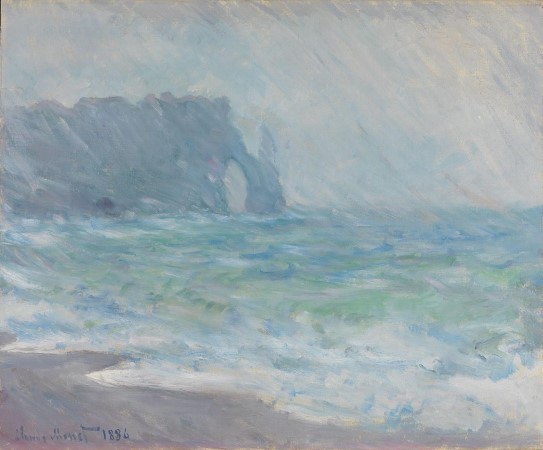Étretat in the Rain
Claude Monet
Transcription
Wenche Volle:
Étretat in the Rain, painted in 1886 by Claude Monet, is one of the most important paintings in the National Museum’s collection.
Narrator:
National Museum curator Wenche Volle tells us about the French artist Claude Monet, one of the great Impressionists.
Wenche Volle:
“Impressionists” is the term we use to describe a particular group of artists who were obsessed by capturing fleeting moments, fleeting impressions of colour. Most Impressionists worked outdoors, painting directly from their subjects. Their goal was to convey their personal impression of being at a particular place at a particular time.
Narrator:
In September 1885, Claude Monet took his family on an excursion to Étretat, a small village in Normandy on the French coast, in an area that was famous for its unusual rock formations. Monet had plans to do “a lot” of painting, and so he needed a bit of help.
Wenche Volle:
Monet had two children from an earlier marriage and six children with his current wife. So this was a large family and all the children played their part – helping Monet day in and day out by carrying his canvases and painting equipment from place to place. As a result, he was able to start work on over 50 canvases that autumn. This large number was also achieved thanks to Monet’s new method of working, whereby he would work on several canvases in parallel. On a single day, he might be working in six different places.
Narrator:
Monet completed Étretat in the Rain in 1886, the same year that he finally experienced great success, with exhibitions in France and the United States. Four years later, the painting ended up in Oslo.
Wenche Volle:
In 1890, the painting was exhibited at the Autumn Exhibition in Kristiania (as Oslo was then known), and it was purchased by the National Gallery. It was Monet’s very first painting to be bought by a public collection, so that’s something rather special. Étretat in the Rain is a good example of Monet’s Impressionist paintings. By now, people are disappearing from his compositions, the colours are becoming paler and prettier, the brushstrokes are more lively, and the actual subject is simplified. In a way, it’s just as though you are standing out in the rain looking at the landscape. You get this immediate sensation of being on the coast in rainy weather.